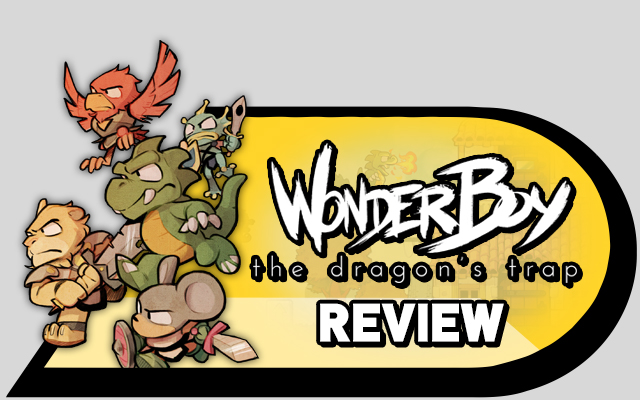
The Nintendo Switch having no games is an oft-repeated narrative that is simply not true. Not many retail games? Sure, that’s something I could agree with. But no games? What about Blaster Master Zero? Snipperclips? Fast RMX? Since launch, the Switch has carved out a niche for itself as the home for a host of fun digital entries, mostly indie, and often times retro or retro-inspired. Wonder Boy: The Dragon’s Trap is on such title. It is, at it’s core, an HD remaster of an 8-bit title, that title being Wonder Boy III: The Dragon’s Trap for the Sega Master System. These sort or remasters only work if a) the base game’s gameplay holds up and b) the game has sufficient polish while still not losing the essence of the original. So, how does Wonder Boy: The Dragon’s Trap stack up?
So what’s this about?
Wonder Boy III: The Dragon’s Trap is actually a direct sequel to Wonder Boy in Monster Land, and so is, consequently, Wonder Boy: The Dragon’s Trap. The game starts with a truncated and easy version of the early Wonder Boy final boss fight…but ends with our titular hero falling under a terrible curse! Well, maybe not THAT terrible, as far as curses go, since you become a fire breathing dragon with a useful projectile. Still, curses are curses and need to be broken. And so Wonderboy (or, if you so choose, Wondergirl in the remake) sets off to lift the spell placed upon him.
The game is a testament to the fact that good dame design is eternal. This game, originally released over 28 years ago, was an early example of a nonlinear, exploration and upgrade platformer. In other words, it’s more or less a “Metroidvania.” As you explore the game, you gain additional “cursed” forms that provide you with new abilities that let you explore previously inaccessible areas. A mouse form lets you climb walls, a piranha form lets you swim, etc. These are all abilities that were present in the original game, and the formula still stands up. What you have here is, for better or worse, a classic game with a fresh coat of paint.

What does it do right?
Wonder Boy III: The Dragon’s Trap is a faithful reproduction of the original title supplemented with gorgeous hand drawn art and remixed music. The game also includes bonus areas and the option to play as a female protagonist, but the level design, items, and basic controls remain more or less identical to the Sega Master System classic. To drive this point home further, players can switch to retro graphics and sounds with the push of a button. You even have additional display options here, just in case you like your old school sprites accompanied by the appropriate CRT scan lines. This is a fun feature that can make traversing the same area feel fresh, which is a welcomed addition in a game that features a decent amount of backtracking. It is also a reminder of just how great games looked and sounded on the Sega Master System. I highly recommend retro gaming fans that may have previously gamed mostly on Nintendo system to check out more titles on the system if they get a chance.
The gameplay itself is solid and benefits greatly from the extra buttons afforded by modern consoles. Switching through items on the fly is a particularly nice feature. The controls are tight and responsive, but it should be noted that the hitboxes just feel more natural in 8-bit mode. This might just be me, but I think it’s the result of expecting modern games to be more generous with that sort of collision detection. The game can be tough but never feels unfair, and the wide variety of cursed forms make it so the game seldom feels stale. It also contains some RPG elements, which is good so if you’re a fan of collecting coins and upgrading your armor.
The final verdict
This is a remaster that was clearly made with love and reverence for its source material. That being said, it suffers from many of the limitations of said source materials. When you strip away new art and music (both of which are high quality and amazingly implemented) you still have an 8-bit game from 1987. This means you some antiquated design elements and simple animations. The fact that you can’t switch your forms on the fly from the get go, and that it is still not as simple as a button press later on, feel like decisions that you wouldn’t see in a newly created game. Still, it is a testament to the quality of this game that it still stands up. I would put the original game above many modern indie releases mechanically, and the extra features push this into must-own territory for Switch owners looking for classic platforming action.
- Sunsoft is Back! Retro Game Selection (Switch) Review - September 4, 2024
- Spidersaurs (Nintendo Switch) Review - July 23, 2022
- Chrono Cross: The Radical Dreamers Edition (Switch) Review - June 11, 2022









